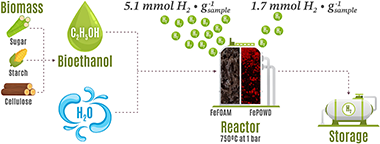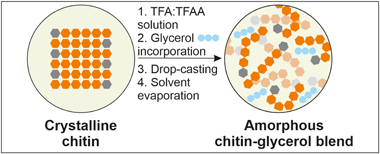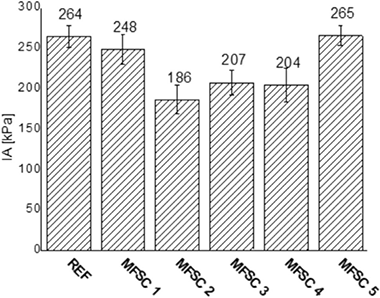Scientific Papers in SCI
2024
2024
Nanotecnología en Superficies y Plasma
Green hydrogen production using doped Fe2O3 foams
Damizia, M; Lloreda-Jurado, PJ; De Filippis, P; de Caprariis, B; Chicardi, E; Sepúlveda, RInternational Journal of Hydrogen Energy, 51 (2024) 834-845
Show abstract ▽

Hydrogen is the ideal energy vector to reduce our fossil-fuels dependency and diminish the climate change consequence. However, current production is still methane based. It is possible to produce hydrogen using bioethanol from the alcoholic fermentation of organic waste by chemical looping processes, but unfortunately current redox systems generate hydrogen with significant traces of CO. In the case of proton exchange membrane fuel cells (PEMFC), hydrogen must be highly purified to produce electricity. Here, high porosity inter-connected Fe2O3 foams doped with 2 wt% Al2O3 were manufactured by the freeze-casting method, obtaining around 5.1 mmol H2$g?1 sample of highly pure hydrogen (<10 ppm of CO) consuming only 3.42 mmol of ethanol on each redox cycles, with no deactivation. This result shows the possibility of using an abundant and inexpensive raw material as the iron oxide to scale-up the direct pure H2 production and facilitates its use in the automotive sector.
January, 2024 | DOI: 10.1016/j.ijhydene.2023.09.008
Química de Superficies y Catálisis
Natural hydrogen in the energy transition: Fundamentals, promise, and enigmas
Blay-Roger, R; Bach, W; Bobadilla, LF; Reina, TR; Odriozola, JA; Amils, R; Blay, VRenewable & Sustainable Energy Reviews, 189 (2024) 113888
Show abstract ▽
Beyond its role as an energy vector, a growing number of natural hydrogen sources and reservoirs are being discovered all over the globe, which could represent a clean energy source. Although the hydrogen amounts in reservoirs are uncertain, they could be vast, and they could help decarbonize energy-intensive economic sectors and facilitate the energy transition. Natural hydrogen is mainly produced through a geochemical process known as serpentinization, which involves the reaction of water with low-silica, ferrous minerals. In favorable locations, the hydrogen produced can become trapped by impermeable rocks on its way to the atmosphere, forming a reservoir. The safe exploitation of numerous natural hydrogen reservoirs seems feasible with current technology, and several demonstration plants are being commissioned. Natural hydrogen may show variable composition and require custom separation, purification, storage, and distribution facilities, depending on the location and intended use. By investing in research, in the mid-term, more hydrogen sources could become exploitable and geochemical processes could be artificially stimulated in new locations. In the long term, it may be possible to leverage or engineer the interplay between microorganisms and geological substrates to obtain hydrogen and other chemicals in a sustainable manner.
January, 2024 | DOI: 10.1016/j.rser.2023.113888
Fotocatálisis Heterogénea: Aplicaciones
Ba3(PO4)2 Photocatalyst for Efficient Photocatalytic Application
Naciri, Y; Ahdour, A; Benhsina, E; Hamza, MA; Bouziani, A; Hsini, A; Bakiz, B; Navio, JA; Ghazzal, MNGlobal Challenges
Show abstract ▽
Barium phosphate (Ba-3(PO4)(2)) is a class of material that has attracted significant attention thanks to its chemical stability and versatility. However, the use of Ba-3(PO4)(2) as a photocatalyst is scarcely reported, and its use as a photocatalyst has yet to be reported. Herein, Ba-3(PO4)(2) nanoflakes synthesis is optimized using sol-gel and hydrothermal methods. The as-prepared Ba-3(PO4)(2) powders are investigated using physicochemical characterizations, including XRD, SEM, EDX, FTIR, DRS, J-t, LSV, Mott-Schottky, and EIS. In addition, DFT calculations are performed to investigate the band structure. The oxidation capability of the photocatalysts is investigated depending on the synthesis method using rhodamine B (RhB) as a pollutant model. Both Ba-3(PO4)(2) samples prepared by the sol-gel and hydrothermal methods display high RhB photodegradation of 79% and 68%, respectively. The Ba-3(PO4)(2) obtained using the sol-gel process exhibits much higher stability under light excitation after four regeneration cycles. The photocatalytic oxidation mechanism is proposed based on the active species trapping experiments where O-2(center dot-) is the most reactive species. The finding shows the promising potential of Ba-3(PO4)(2) photocatalysts and opens the door for further investigation and application in various photocatalytic applications.
January, 2024 | DOI: 10.1002/gch2.202300257
2023
2023
Materiales de Diseño para la Energía y Medioambiente
Plasticized, greaseproof chitin bioplastics with high transparency and biodegradability
Heredia-Guerrero, JA; Benitez, JJ; Porras-Vazquez, JM; Tedeschi, G; Morales, Y; Fernandez-Ortuno, D; Athanassiou, A; Guzman-Puyol, SFood Hydrocolloids, 145 (2023) 109072
Show abstract ▽

A mixture of trifluoroacetic acid:trifluoroacetic anhydride (TFA:TFAA) was used to dissolve chitin from shrimp shells. Free-standing films were prepared by blending the chitin solution and glycerol at different percentages, followed by drop-casting, and the complete evaporation of the solvents. After this process, the chitin matrix showed an amorphous molecular structure, as determined by X-ray diffraction. Optical, mechanical, thermal, and antioxidant properties were also thoroughly investigated. The incorporation of glycerol induced a plasticizing effect on the mechanical response of films and improved their transparency. In addition, hydrodynamic and barrier properties were determined by contact angle and water vapor/oxygen transmission rates, respectively, and revealed typical values of other polysaccharides. These bioplastics also presented an excellent greaseproof behavior with the highest degree of oil repellency as determined by the Kit test. Moreover, the overall migration was evaluated by using Tenax & REG; as a dry food simulant and levels were compliant with European regulations. Their antifungal properties were tested using Botrytis cinerea as a model. Biodegradability was also determined by measuring the biological oxygen demand in seawater. Degradation rates were high and similar to those of other fully-degradable materials.
December, 2023 | DOI: 10.1016/j.foodhyd.2023.109072
Nanotecnología en Superficies y Plasma
Spherosilicate-modified epoxy coatings with enhanced icephobic properties for wind turbines applications
Kozera, R; Zietkowska, K; Przybyszewski, B; Boczkowska, A; Sztorch, B; Paku, D; Przekop, RE; Trzcinski, J; Borras, AColloids and Surfaces A-Physicochemical and Engineering Aspects, 679 (2023) 132475
Show abstract ▽

Industries around the world use active methods, which include thermal, mechanical and chemical approaches, to reduce icing on aerodynamic surfaces such as wind turbines and aircraft. However, they are often inefficient, costly, and pollute the environment. For years, new coatings with anti-icing properties (so-called icephobic coatings) have been developed to either replace or work in tandem with active systems. In this study, coatings were designed based on an epoxy gelcoat commonly used for wind turbines through chemical modification with spherosilicate derivatives. Di- and tri-functional spherosilicates have both groups that increase the degree of hydro-/icephobicity of composites , groups capable of interacting with epoxy resin and amine hardener. The icephobicity of the surface was determined using ice adhesion. The lowest value of this parameter reached a value of 186 kPa, a 30 % reduction compared to the unmodified coating. In addition, the hydrophobicity of the surface was determined (the highest water contact angle was equal to 103 degrees). A correlation was observed, proven in many works, that as the surface roughness increases, the anti-icing properties deteriorate. For individual modifications, it was also shown that hydrophobicity has a positive effect on ice adhesion. The work also examined the surface zeta potential and determined the durability of the properties after 100 icing/deicing cycles.
December, 2023 | DOI: 10.1016/j.colsurfa.2023.132475
- ‹ previous
- 6 of 410
- next ›














